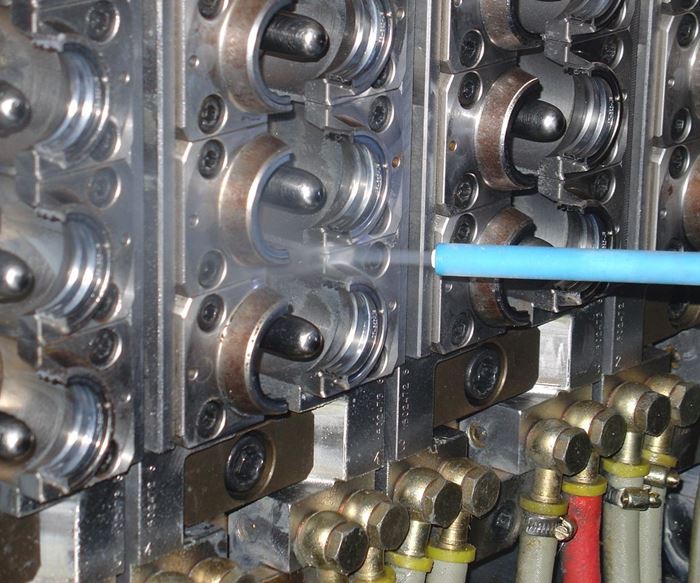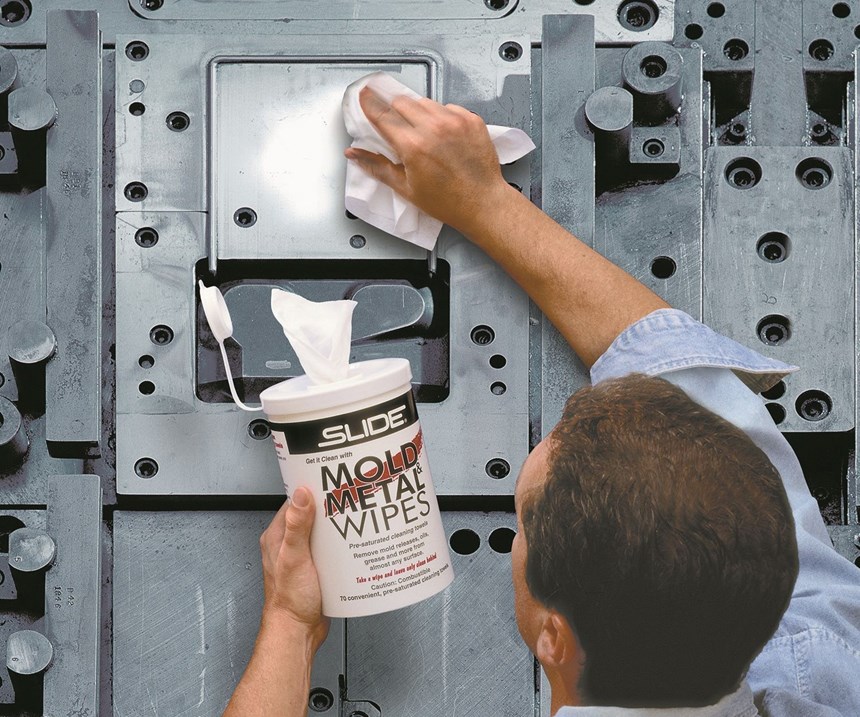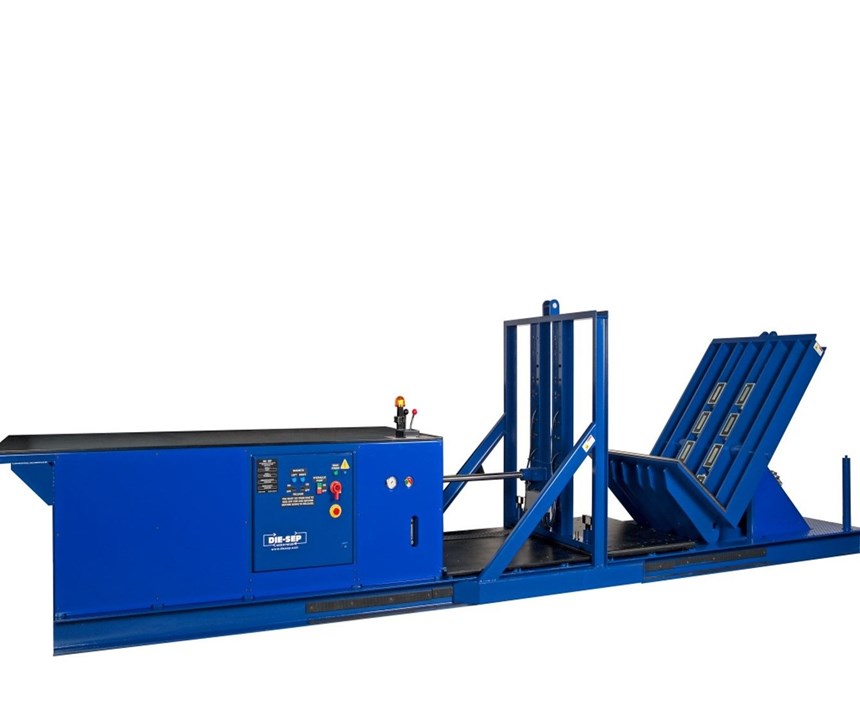In recently published roundtable discussions about moldmaking trends and challenges, participants indicated that increasingly complex mold designs and functions have been central in driving industry advancements in services, products and technologies. MoldMaking Technology uncovered that the same forces drive mold-maintenance strategies. Professionals from a few supplier companies share their take on the topic.
Maintenance Matters More Today
Mold maintenance expert and MoldMaking Technology columnist Steve Johnson, president of MoldTrax (Ashland, Ohio), says that molds continue to advance in their design and build. The industry is seeing molds with higher cavitation, faster cycle times and more complexity in the use of hot runner systems, in-mold functions, over-molding, process sensors, engineered resins, mold-monitoring devices, rotating, spinning plates and so on. Because of this, molds today require a higher level of shop maintenance skills and management strategies to safely and effectively run and maintain the molds. “Original equipment manufacturers (OEMs) continue to raise the bar as well, requiring their molds to run longer, more cheaply, faster and more reliably while molding quality parts,” he adds. “They want mold builders to go beyond the million-cycle warranties which means that the molder must take better care of the mold to maximize tooling and mold life.”
Louis Bowler, executive vice president of sales at Die Sep (Lake Geneva, Wisconsin), shares Johnson’s views, saying that the attitude of management toward mold maintenance is changing. “Up until about 10 years ago, mold maintenance was regarded as a necessary pursuit that often was too expensive. Everyone knew that the molds needed to be maintained, but getting ahead of the game and providing the tool room with the equipment it needed to sustain a preventative maintenance (PM) program was not a priority.”
Brian Finkel, manager of Repairs-Service of North America for Mold-Masters / Milacron (Georgetown, Ontario, Canada), says, “We see more customers requesting pre-scheduled PM runs on their molds and systems.”
Up until about 10 years ago, mold maintenance was regarded as a necessary pursuit that often was too expensive.
Michael Muth, president of Slide Products Inc. (Wheeling, Illinois) concurs, saying that companies have become more proactive about using advanced mold-maintenance schedules and products. “They realize that an ounce of prevention can be worth a pound of cure. Molders are using predictive patterns to help schedule their mold maintenance before the processing issues pop up and delay or slow down production,” he says.
“People recognize how the mold maintenance facet of their molding operations greatly impacts their overall equipment effectiveness (OEE) scores,” Steve Wilson, Global Business Unit Director – Plastics, Rubber & Composites for Cold Jet LLC (Loveland, Ohio) says. “Traditional, manual, in-machine cleaning methods often are ineffective and have a negative effect on several OEE scores, including Quality Loss, Availability Loss and Performance Loss.” He says that molders are looking to improve methodologies for cleaning the molds in-situ and at operating temperatures to improve overall plant-OEE scores.
More Effective Cleaning Strategies Are Emerging
Mold-cleaning strategies, like the molds themselves, take many forms and the array of options is wide. Suppliers understand that customers want efficient and effective methods that will not affect surface treatments adversely or damage the critical-to-function areas of molds. Steve Wilson says that Cold Jet has developed dry-ice cleaning solutions that incorporate the use of 0.3-millimeter dry-ice MicroParticles instead of traditional 3.0-millimeter pellets. “MicroParticles are less aggressive and increase the area of coverage,” he says. “In the dry-ice cleaning process, the kinetic energy of the particles delivers most of the cleaning effect. Enabling molders to adjust their cleaning levels is a big advantage for those who use surface treatments.” He says that it takes less air to fully accelerate the MicroParticle to proper cleaning velocity, so systems connect using ½-inch or even 3/8-inch air lines and consume around 30 cubic feet per minute of air and 0.6 pounds per minute of dry ice, whereas 3.0-millimeter systems typically require ¾-inch or 1-inch air lines, which often are not available near the molding press. “Additionally, using dry-ice cleaning is environmentally responsible and eliminates the use of chemicals that often contain volatile organic compounds (VOCs).”
Expanding on that, Michael Muth of Slide Products says, “In the United States, emissions of VOCs to the outdoors are regulated by the EPA and some states mostly to prevent the formation of ozone, a constituent of photochemical smog. Many VOCs form ground-level ozone by ‘reacting’ with sources of oxygen molecules such as nitrogen oxides (NOx) and carbon monoxide (CO) in the atmosphere in the presence of sunlight.” California is the state that most heavily regulates VOCs at this point, Muth says, but it is expected that other states and regions in the United States will follow California’s lead and start limiting the VOC content of certain product categories, like spray mold cleaners and releases. Canada has already announced that it plans to adopt the VOC standards that California has implemented, he says. “Slide Products has been focusing on developing and introducing new VOC-compliant chemical processing aids to help molders and moldmakers meet these new VOC limits without losing the needed functionality.”
Customers want to clean the mold without altering any of the mold’s critical dimensions or wearing parting lines and vents while protecting the surface treatments.
Mold-Masters’s Brian Finkel says that the company’s repair facility has adopted new processes for cleaning and maintaining molds for customers, including a laser cleaner. “It removes rust, discoloration and burning from the part surface of the tool. It does this by removing one micron at a time. It will not remove the steel’s surface. It only burns away the surface contaminants.”
Training, Data Collection and Safety Are Key
MoldTrax’s Steve Johnson says that many repair shops are not equipped for success through the application of today’s cleaning technologies, like ultra-sonics, dry ice, plastic media and laser blasting. “Shop designs and layouts need to be more conducive to mold size, mold pull pace and work flow through the shop,” he says. “Benches and tools need to be arranged in a more work-cell-like layout to afford the technician every chance to work more safely and efficiently. MoldTrax stays in touch with new products and designs new, hands-on training methods to equip its customers with the most current information and bench skills.”
Regarding safety, Die Sep’s Louis Bowler emphasizes that by eliminating as much manual labor as possible from the mold-maintenance process, companies reduce the risk for worker injuries. He says that, historically, repair technicians have had no choice but to open molds with pry bars and cranes. When a mold is jammed because the parting line is not opening parallel, technicians resort to using house jacks or hydraulic jacks to force open the mold. “Nowadays, mold separators are available that use hydraulics to do the heavy work of opening, tipping and closing the mold, and they use magnets to mount the mold,” he says. “Toolroom technicians do not have to contend with the labor or dangers of handling molds. Furthermore, the job is completed in a fraction of the time without the risk of damage to parting-line surfaces. Reducing or eliminating these battles when molds get jammed not only saves the technicians’ wrists, elbows, shoulders and backs, it saves their attitude and improves morale in the tool room as well.”
Maintenance is no longer an afterthought for companies but a necessity.
Josh Kauzlarich, North America sales representative for Millutensil SRL (Milan, Italy), says that the company’s line of machinery for molds and dies is multi-functional and can be used for mold cleaning and repair, spotting and validation. “The Millutensil system provides a safer way to handle, disassemble and maintain dies and molds because it eliminates mold damage and potential safety risks that come from using traditional overhead cranes. Users can equip it with swivel and tilting plates, which provide more ergonomic access to each half of the mold without requiring the technician to remove it from the Millutensil press.”
MoldTrax’s Steve Johnson sums it up when he says, “Maintenance is no longer an afterthought for companies but a necessity, along with more complete and accurate documentation for OEMs who demand better care for their molds.”
Related Content
What You Need to Know About Hot Runner Systems and How to Optimize Their Performance
How to make the most out of the hot runner design, function and performance.
Read MoreMachine Hammer Peening Automates Mold Polishing
A polishing automation solution eliminates hand work, accelerates milling operations and controls surface geometries.
Read MoreWhat is Scientific Maintenance? Part 2
Part two of this three-part series explains specific data that toolrooms must collect, analyze and use to truly advance to a scientific maintenance culture where you can measure real data and drive decisions.
Read MoreThe Ins and Outs of Hot Runner Temperature Control
A training checklist that explains the why and how of proper hot runner temperature control and system management.
Read MoreRead Next
Are You a Moldmaker Considering 3D Printing? Consider the 3D Printing Workshop at NPE2024
Presentations will cover 3D printing for mold tooling, material innovation, product development, bridge production and full-scale, high-volume additive manufacturing.
Read MoreReasons to Use Fiber Lasers for Mold Cleaning
Fiber lasers offer a simplicity, speed, control and portability, minimizing mold cleaning risks.
Read MoreHow to Use Strategic Planning Tools, Data to Manage the Human Side of Business
Q&A with Marion Wells, MMT EAB member and founder of Human Asset Management.
Read More














.jpg;maxWidth=300;quality=90)










.jpg;maxWidth=970;quality=90)